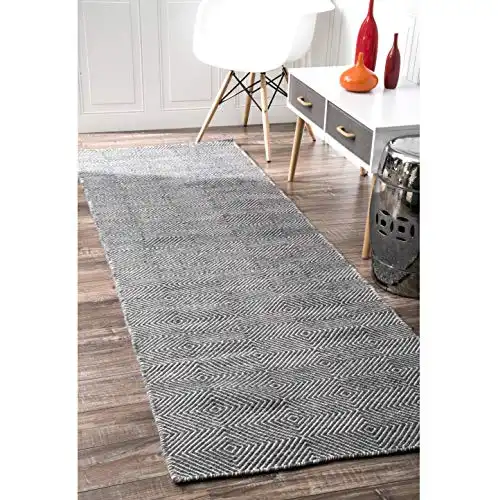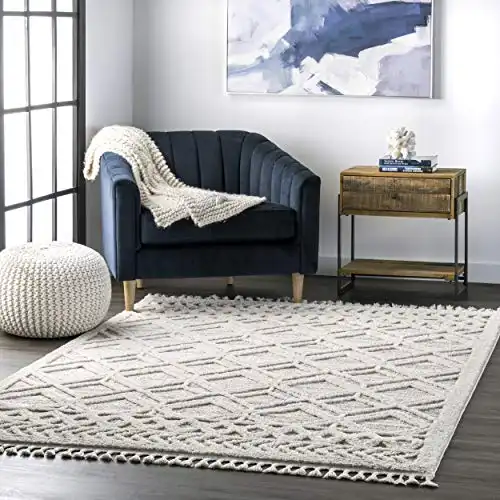- You are here:
- Home »
- Non Toxic Home Poducts »
- Polypropylene vs Wool Rug: Which One Is Better?
Polypropylene vs Wool Rug: Which One Is Better?
In this article, we will explore the differences between polypropylene and wool rugs to help you make the best decision when shopping for a rug. Each of these rugs comes with its own benefits and drawbacks, so understanding the differences between them is important for making an informed decision. So, let´s start!
What is a Wool Rug?
Wool rugs are made from wool fibers, which are spun into yarn and then woven together to create a rug. The wool is obtained from sheep and other animals and the yarn is woven into a variety of patterns and colors.
Wool rugs are incredibly soft, warm, and durable, making them a popular choice for bedrooms and living rooms. They provide excellent insulation from cold floors, help reduce noise levels, and are naturally fire-retardant. Additionally, wool rugs last for many years with proper care.
What is a Polypropylene Rug?
Polypropylene rugs are made from synthetic fibers, typically in a range of colors. The synthetic fibers are obtained from petroleum-based plastics, which are melted and spun into yarn and then woven together to create the rug.
Adhesives and glues are then used to bind the fibers together. Polypropylene rugs are stain-resistant, very durable, and relatively inexpensive.
Wool Rug Pros and Cons
The main advantages of wool rugs include:
They’re made from natural fiber, which makes them environmentally friendly.
- Wool rugs are hypoallergenic and resist dust mites, making them a good choice for people with allergies.
- Available in a wide range of colors and styles.
- They absorb sound, making them ideal for children´s rooms or homes with hardwood floors.
- They insulate against both heat and cold, making them comfortable to walk on in any season.
- Wool rugs naturally repel water, so they won’t stain as easily as other rugs.
- Wool is naturally fire retardant, making it a safe choice for homes with small children or pets.
- If treated with plant-based or AZO-free dyes, wool rugs are non-toxic and safe for the environment.
- They´re biodegradable, meaning they’ll eventually break down over time instead of sitting in a landfill.
- These natural rugs can last up to 30 years if properly cared for.
On the other hand, these natural rugs also come with some drawbacks:
- They are more expensive than other types of rugs.
- Wool can be scratched or punctured easily, so they may not be the best choice for high-traffic areas.
- The color of wool rugs may fade with time and sun exposure.
- They may need special care, like professional cleaning or brushing, to remain in good condition.
- They can shed, so they may not be the best choice for people with allergies.
- They´re not pet-friendly, as pets´ claws may snag and tear the fibers.
Polypropylene Rug Pros and Cons
The main advantages of polypropylene rugs include:
- They´re inexpensive and widely available.
- Polypropylene rugs are durable and resistant to staining, making them a great choice for high-traffic areas.
- They´re low maintenance and easy to clean with regular vacuuming or machine washing.
- They come in a wide range of colors and styles.
However, polypropylene rugs also have some drawbacks:
- Polypropylene rugs don´t insulate; they can be cold to the touch.
- They are not as soft or comfortable as wool rugs.
- They don´t absorb sound, so they can be noisy in high-traffic areas.
- Polypropylene rugs may not last as long as wool rugs.
- Unlike natural rugs made of wool or cotton, polypropylene rugs may off-gas, releasing toxic chemicals into the air.
- They´re not biodegradable, so they´ll sit in a landfill when you discard them.
Wool vs Polypropylene Rug: Comparison
In this section, we’ll take a look at how wool and polypropylene rugs compare in terms of cost, durability, insulation, sound absorption, and more.
Feel
Wool rugs have a natural, soft feeling that is often more comfortable than the synthetic feel of polypropylene rugs, which tend to be quite stiff.
Winner: Wool
Maintenance
Wool rugs require professional cleaning and occasional brushing to remain in good condition. Polypropylene rugs are low-maintenance and can be easily cleaned with regular vacuuming or machine washing.
Winner: Polypropylene
Durability
Wool rugs, as long as they´re properly cared for and kept in low-traffic areas, can last for decades. Synthetic rugs will wear down much faster, but they´re still a better choice for high-traffic areas because keeping them clean is easier and they won´t shed or fray.
Winner: Wool (for low-traffic areas), Polypropylene (for high-traffic areas)
Insulation and Sound Absorption
Wool rugs provide insulation against both heat and cold, making them comfortable to walk on in any season. They also absorb sound, making them ideal for kids´s rooms or homes with hardwood floors. Polypropylene rugs do not provide insulation or absorb sound and can be cold to the touch.
Winner: Wool
Cost
Wool rugs tend to be more expensive due to their natural fibers and quality construction, while polypropylene rugs are generally very affordable because they are made from synthetic materials and relatively inexpensive.
Winner: Polypropylene
Safety
Wool rugs are naturally fire retardant, making them safer for homes with small children or pets. Polypropylene rugs may off-gas and release toxic chemicals into the air, making them a less safe option.
Winner: Wool
Read More: How to Speed Up Carpet Off-Gassing?
Environmental Impact
Wool rugs are biodegradable and will eventually break down over time, while polypropylene rugs will remain in landfills for many years. Also, the manufacturing processes for polypropylene rugs use more energy and chemicals than wool rugs, so they are less eco-friendly.
Winner: Wool
Which One Should You Choose?
The type of rug you choose will depend on your needs and budget. Choose a polypropylene rug if:
- You´re looking for an inexpensive rug for a high-traffic area
- You prefer low-maintenance rugs
- You don´t need insulation or sound absorption
Choose a wool rug if:
- You´re looking for a luxurious, comfortable rug
- You need insulation or sound absorption
- You’re concerned about safety and environmental impact of the rug
- You have the budget for it
The choice is yours! Both wool and polypropylene rugs have their own set of advantages and drawbacks. Consider your needs carefully before making a decision. Whichever one you choose, remember to take good care of it and it will reward you with years of enjoyment.
FAQs
Q: How often should I vacuum my wool rug?
A: Vacuuming your wool rug once or twice a week is recommended to keep it looking its best. Pay special attention to areas where dirt and debris accumulate, such as walkways or high-traffic areas. Make sure to use the right attachment on your vacuum cleaner so that you don’t damage the rug’s fibers.
Q: How do I clean spills on my wool rug?
A: Blot any spills with a clean cloth as soon as possible – don’t rub or scrub! Use cold water and
Once finished, blot the area with a dry cloth until it is completely dry. Do not use any harsh chemicals or cleaning solutions on your wool rug as they can damage the fibers and cause fading.
Read More: Best Natural Carpet Odor Eliminators
Q: How do I prevent shedding on my wool rug?
A: Shedding of wool fibers is normal and will generally stop after a few weeks or months depending on how often you use your rug. Vacuuming your rug regularly (at least once a week) can help to reduce shedding and keep it looking its best.
You can also try using an anti-static spray designed for carpets on your rug every couple of months to help reduce static that may contribute to excess shedding.
Q: How do I store a wool rug?
A: Wool rugs should be stored in a cool, dark area with plenty of ventilation. Make sure to wrap your rug in a breathable material such as cotton or canvas and avoid using plastic that can trap moisture and cause your rug to mildew.
If you’re storing your rug for long periods of time, it’s also important to periodically check it for signs of pests or mold.
Q: What is the best way to protect my wool rug from wear and tear?
A: The best way to protect your wool rug from wear and tear is by placing it in an area that doesn’t receive heavy foot traffic. If this isn’t possible, you can also use rugs pads underneath your rug to provide a cushioning layer between the fibers of your rug and the flooring.
Additionally, make sure to vacuum regularly to reduce dirt buildup on your rug that can cause damage over time. Finally, avoid using furniture with sharp edges or legs on top of your wool rug as they can increase friction and cause wear down the fibers more quickly.
Q: What should I do if my rug develops damage?
A: Depending on the type and severity of the damage, you may be able to repair it yourself or have it professionally repaired. If the damage is minor (such as small holes or tears), you can use a patch kit with materials that match your rug’s fibers to repair it.
If the damage is more severe (like large holes or tears), you will need to take it to a professional rug repair specialist who can help restore your rug back to its original condition.
Q: How long do wool rugs last?
A: With proper care, wool rugs can last for as long as 30 years, but this will vary depending on the quality of the rug and how well you take care of it and where it´s used.
Regular vacuuming, spot cleaning spills immediately, and avoiding sharp furniture pieces are all important steps to help ensure your rug lasts a long time. Also, use your wool rugs in low-traffic areas and keep your pets away from them to help maintain their life and beauty.
Q: Are there any special care instructions for polypropylene rugs?
A: Yes! To ensure your rug lasts as long as possible and looks pristine, you should vacuum regularly and spot-treat spills immediately with mild soap and warm water. You can also machine wash these rugs in lukewarm water on a gentle cycle.
To protect the color of your polypropylene rug, avoid exposing it to direct sunlight or other UV light sources. It’s also important to use a rug pad underneath the polypropylene rug to avoid slipping and bunching.
Q: Are polypropylene rugs safe for pets?
A: Absolutely! Polypropylene is a great choice if you have furry friends in your home as it’s non-toxic and generally resistant to stains from pet accidents. However, it is important to keep your rug clean to ensure no bacterial build-up occurs on the fibers.
Q: How long do polypropylene rugs last?
A: With proper care, a polypropylene rug can last for up to 5 years. However, the fibers are nowhere near as strong as wool and will eventually weaken over time if exposed to heavy foot traffic. So, it is important to regularly clean and inspect your rug for signs of wear or damage.
Q: What should I look for when buying a polypropylene rug?
A: When shopping for a polypropylene rug, look for high-quality materials with reinforced edges specifically designed to last longer than other rugs made with synthetic fibers.
Additionally, consider how the rug’s color may affect the overall feel of your living space and opt for fade-resistant colors if possible. Finally, take your time to compare different rug styles and prices to get the best value for your money.
Read More: What Are Green Label Plus Certified Carpets?
Conclusion
To conclude, while polypropylene rugs are much cheaper than their wool counterparts, they can still provide a great deal of comfort and style in any room. With proper care and maintenance, polypropylene rugs can last for years, making them a great investment.
However, it’s important to remember that they don’t have the same durability as wool and may need to be replaced more often. Wool rugs are also less toxic and more eco-friendly, so if the environment is a priority for you, then wool may be the better choice.
Ultimately, it’s up to you to decide which rug is right for your home. Whether you go with a polypropylene rug or a wool rug, you can be sure that you will be adding a beautiful and comfortable addition to your home. Thank you for reading!
Read More: Are Polyester Rugs Toxic?
About the Author Kamila Flieger
My name is Kamila, and I'm passionate about researching non-toxic, organic products for the home. I believe it's so important to create a safe and healthy environment for our families, and I enjoy helping others do the same.




